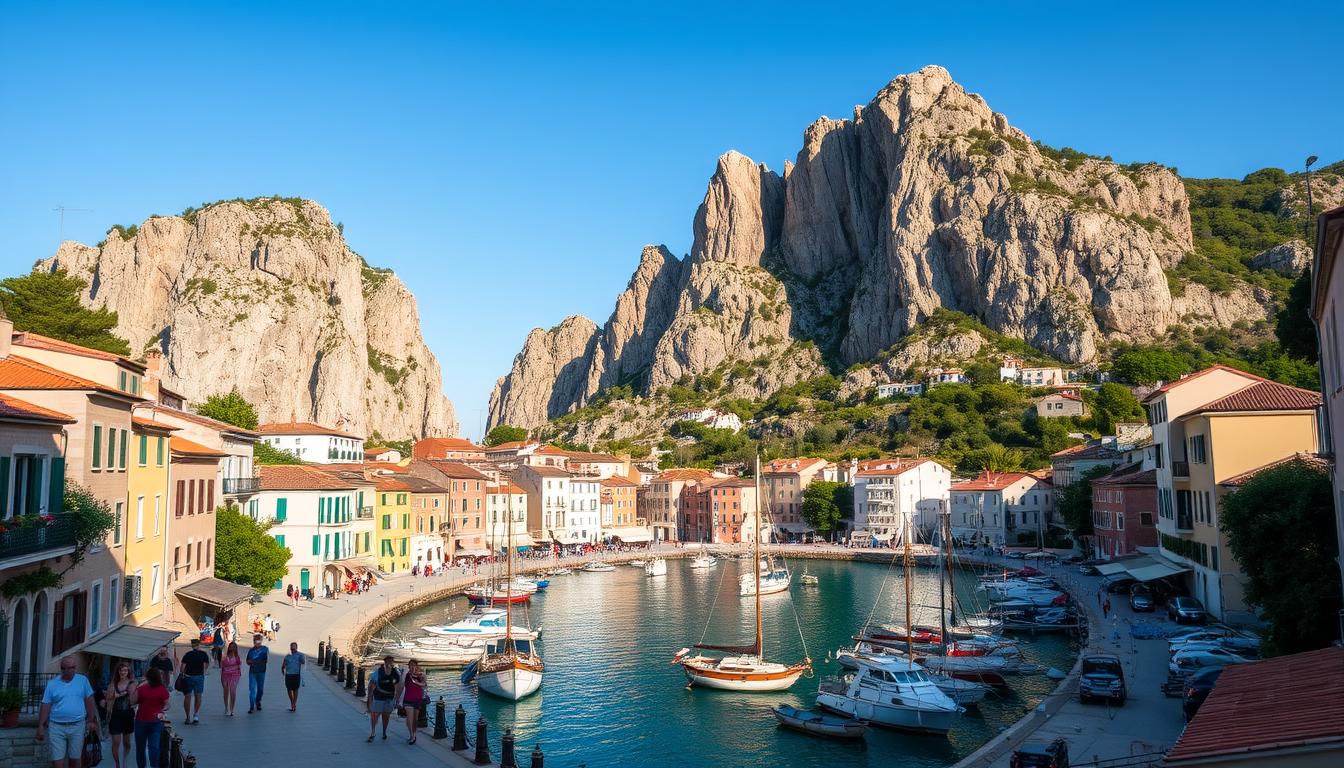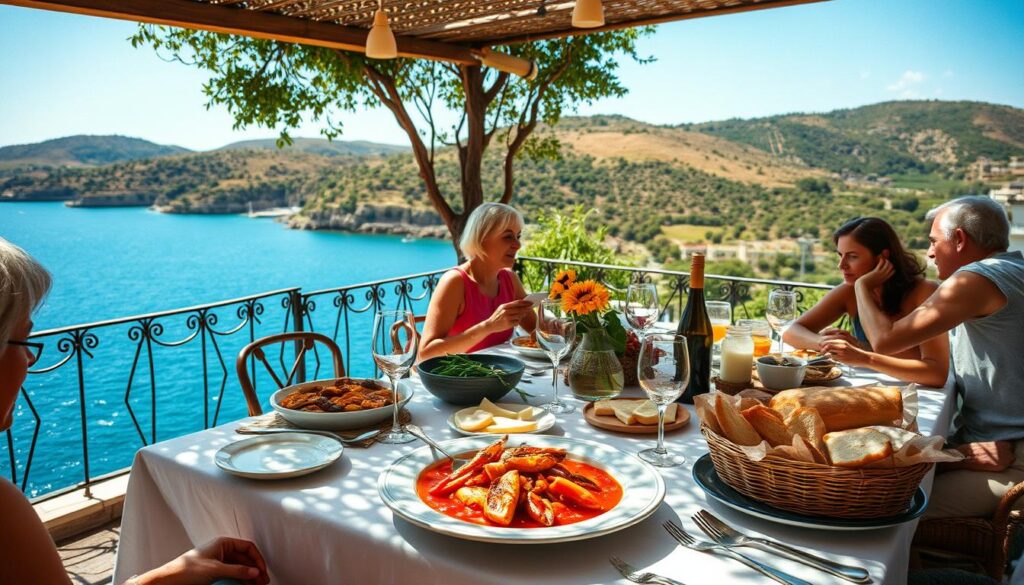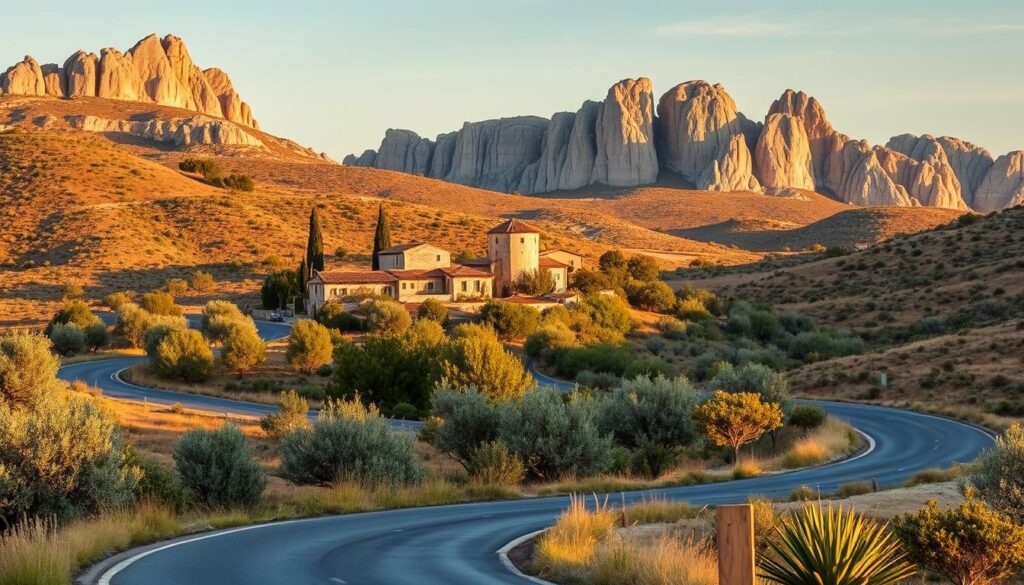Blog
Sardinia, Italy: Slow Travel and Archaeological Sites

Sardinia, a gem of the Mediterranean, is calling out to travelers in 2026 with its promise of slow travel and rich archaeological heritage. This enchanting island offers a unique blend of unspoiled landscapes, crystal-clear waters, and a deep history waiting to be explored.
As a haven for those seeking a more meaningful travel experience, Sardinia embodies the principles of sustainable tourism. Visitors can immerse themselves in the island’s vibrant culture, from the ancient ruins of Tharros to the stunning beaches of Costa Smeralda.
Whether you’re a history buff, a nature lover, or simply looking for a relaxing getaway, Sardinia has something for everyone. Its commitment to preserving its natural beauty and cultural heritage makes it an ideal destination for slow travel enthusiasts.
Key Takeaways
- Explore Sardinia’s ancient archaeological sites, such as Tharros and Su Nuraxi.
- Experience the island’s vibrant culture through its festivals and local cuisine.
- Enjoy the pristine landscapes and crystal-clear waters of Costa Smeralda.
- Embark on a slow travel journey, embracing the island’s relaxed pace.
- Discover Sardinia’s commitment to sustainable tourism practices.
Discovering Sardinia’s Unique Character
Embracing the concept of slow travel, Sardinia reveals its authentic charm through its archaeological sites, local traditions, and Sardinia hiking trails. This approach allows travelers to immerse themselves in the island’s rich cultural tapestry.
The Island’s Cultural Heritage Beyond the Beaches
Sardinia’s cultural heritage extends far beyond its picturesque beaches. The island is home to a myriad of archaeological sites that tell the story of its diverse history, from the Nuragic civilization to the Roman era. These sites offer a glimpse into the lives of the people who once inhabited the island, showcasing their traditions, beliefs, and ways of life.
Why Slow Travel Creates Authentic Sardinian Experiences
Slow travel in Sardinia fosters a deeper connection with the island and its inhabitants. By taking the time to explore the island’s hidden gems, such as secluded beaches, ancient ruins, and traditional villages, travelers can experience the authentic essence of Sardinia. This approach to travel encourages meaningful interactions with locals, allowing visitors to gain a more profound understanding of Sardinian culture and way of life.
Understanding Sardinia’s Archaeological Timeline
Sardinia’s archaeological timeline is a complex and fascinating narrative that spans thousands of years. From the prehistoric era, through the Nuragic period, to the Roman and Phoenician influences, the island’s history is etched into its landscapes and monuments. Understanding this timeline is crucial for appreciating the significance of Sardinia’s archaeological sites and the role they play in defining the island’s Italy off-the-beaten-path appeal.
Planning Your Sardinia Travel 2026 Itinerary
Planning a trip to Sardinia in 2026 requires a thoughtful approach to explore its archaeological sites and cultural heritage effectively. As you prepare for your journey, consider the pace of your travel and how to make the most of your time on this beautiful island.
How to Create a Balanced 10-14 Day Slow Travel Route
Creating a balanced itinerary for Sardinia involves selecting a mix of archaeological sites, cultural experiences, and relaxation. A 10-14 day trip allows you to explore different parts of the island without feeling rushed. Consider dividing your trip into segments, focusing on different regions such as the Costa Smeralda or the historic town of Cagliari.
- Day 1-3: Explore Cagliari and its surroundings
- Day 4-6: Visit archaeological sites in the central part of the island
- Day 7-10: Enjoy the coastal towns and beaches
Choosing the Right Base Towns for Archaeological Exploration
Selecting the right base towns can significantly enhance your archaeological exploration. Towns like Orgosolo and Sassari offer easy access to various historical sites. Consider staying in areas that provide a balance between tranquility and accessibility to main attractions.
| Base Town | Nearby Archaeological Sites |
|---|---|
| Orgosolo | Nuragic sites, prehistoric ruins |
| Sassari | Roman ruins, Phoenician settlements |
Transportation Options: Rental Cars vs. Public Transit
When it comes to transportation, Sardinia offers both rental cars and public transit options. Rental cars provide flexibility, especially for reaching remote archaeological sites. However, public transit can be a more sustainable choice, connecting major towns and some tourist areas.
Navigating Rural Roads and Archaeological Site Access
Navigating rural roads in Sardinia can be challenging due to their narrow and winding nature. If you choose to rent a car, be prepared for these conditions. Many archaeological sites are accessible via these roads, and having a reliable map or GPS is essential.
By carefully planning your itinerary, choosing the right accommodations, and selecting appropriate transportation, you can have a fulfilling and sustainable travel experience in Sardinia in 2026.
Essential Archaeological Sites in Sardinia
The island of Sardinia boasts an impressive array of archaeological treasures, from ancient Nuragic complexes to Roman ruins. This rich historical tapestry makes Sardinia a fascinating destination for those interested in exploring the remnants of past civilizations.
Exploring Nuragic Complexes
Sardinia is perhaps most famous for its Nuragic complexes, which are a testament to the island’s unique prehistoric culture. These ancient stone structures, dating back to the Bronze Age, are scattered throughout the island.
Su Nuraxi di Barumini: Navigating the UNESCO Site
Su Nuraxi di Barumini is one of Sardinia’s most significant archaeological sites and a UNESCO World Heritage Site. This complex is notable for its well-preserved state and provides valuable insights into the lives of the Nuragic people.
Tips for Visiting Su Nuraxi:
- Plan your visit early in the morning to avoid the crowds.
- Wear comfortable shoes as the terrain can be uneven.
- Bring water and sun protection, as shade is limited.
Nuraghe Santu Antine and Nuraghe Losa: Hidden Gems
Nuraghe Santu Antine and Nuraghe Losa are two other significant Nuragic sites worth visiting. While they may not be as widely known as Su Nuraxi, they offer a more intimate and less crowded experience.
Roman and Phoenician Ruins
Sardinia’s history is not limited to the Nuragic period; the island is also home to numerous Roman and Phoenician ruins, reflecting its strategic importance in the Mediterranean.
Nora Archaeological Park: Coastal History
Nora Archaeological Park is a must-visit for anyone interested in Sardinia’s coastal history. The site features remains of Phoenician, Punic, and Roman settlements, showcasing the island’s role as a significant trading hub.
The park’s location on the coast offers breathtaking views and a unique perspective on how ancient civilizations interacted with the sea.
Tharros Ancient City: Tips for the Best Experience
Tharros is another ancient city that provides a fascinating glimpse into Sardinia’s past. Visitors can explore the remains of temples, a theater, and other structures, all set within a beautiful coastal environment.
Tharros Visiting Tips:
| Time of Visit | Best Activities |
|---|---|
| Morning | Explore the ancient ruins and enjoy the coastal views. |
| Afternoon | Relax on the nearby beach or enjoy a meal at a local restaurant. |
Prehistoric Treasures
Sardinia is also home to numerous prehistoric sites that offer insights into the island’s earliest inhabitants.
Necropolis of Anghelu Ruju and Montessu
The Necropolis of Anghelu Ruju and Montessu are significant prehistoric sites featuring ancient tombs. These sites provide a poignant reminder of Sardinia’s rich prehistoric heritage.
Giants’ Tombs and Domus de Janas are other prehistoric features that dot the Sardinian landscape. These ancient burial sites are steeped in mystery and offer a fascinating glimpse into the island’s early cultures.
Sardinia’s archaeological sites are a treasure trove of historical and cultural significance, offering something for every interest and curiosity. Whether you’re drawn to the Nuragic complexes, Roman ruins, or prehistoric tombs, Sardinia is a destination that promises an enriching and unforgettable experience.
How to Practice Sustainable Tourism in Sardinia
With its unspoiled beauty and deep-rooted traditions, Sardinia is a perfect setting for practicing sustainable tourism. As travelers, we have the opportunity to contribute positively to the island’s environment and local communities.
Supporting Local Artisans and Businesses
One of the most effective ways to practice sustainable tourism in Sardinia is by supporting local artisans and businesses. This can be achieved by:
- Purchasing handmade crafts and local products
- Dining at family-run restaurants that serve traditional Sardinian cuisine
- Staying at locally-owned accommodations that reflect the island’s culture
By doing so, travelers can help ensure that their visit benefits the local economy and preserves Sardinia’s unique cultural identity.
Choosing Eco-friendly Accommodations and Tours
Sardinia offers a range of eco-friendly accommodations and tour operators that adhere to sustainable practices. Look for:
- Hotels and agriturismos that use renewable energy sources
- Tour operators that follow environmentally responsible practices
These choices can significantly reduce the environmental impact of your visit.
Minimizing Impact While Visiting Archaeological Sites
When visiting Sardinia’s archaeological sites, it’s crucial to minimize your impact. This includes:
- Staying on designated paths to avoid damaging ancient structures
- Not touching or removing any artifacts
- Being mindful of your surroundings and other visitors
By being a responsible visitor, you help preserve these sites for future generations.
By adopting these sustainable tourism practices, travelers can enjoy all that Sardinia has to offer while contributing to the island’s long-term sustainability.
Sardinia’s Hiking Trails: Connecting History and Nature
Exploring Sardinia on foot reveals a rich tapestry of archaeological sites and breathtaking landscapes. The island’s diverse hiking trails offer a unique way to experience its cultural heritage and natural beauty.
Coastal Paths with Archaeological Significance
Sardinia’s coastal hiking trails provide stunning views of the Mediterranean Sea while leading to ancient archaeological sites. These paths allow hikers to explore the island’s rich history, from Phoenician ruins to Roman settlements.
Sinis Peninsula Archaeological Hikes
The Sinis Peninsula is home to some of Sardinia’s most significant archaeological sites, including the ancient city of Tharros. Hiking trails in this area offer a glimpse into the island’s past, with ruins dating back to the 8th century BC.
Eastern Coast Ancient Settlements Trails
The eastern coast of Sardinia features hiking trails that pass through ancient settlements, such as the town of Tortolì. These trails provide insight into the lives of the island’s ancient inhabitants.
Mountain Trails Revealing Ancient Settlements
Sardinia’s mountainous regions are home to numerous ancient settlements and archaeological sites. Hiking trails in these areas offer a chance to explore the island’s prehistoric past.
Supramonte Prehistoric Routes
The Supramonte region features hiking trails that lead to prehistoric sites, including ancient nuragic complexes. These trails offer a unique opportunity to experience Sardinia’s natural beauty and rich cultural heritage.
How to Prepare for Archaeological Hiking
Before embarking on a hiking adventure in Sardinia, it’s essential to prepare properly. This includes wearing suitable footwear, bringing necessary supplies, and researching the trail to ensure a safe and enjoyable experience.
Authentic Sardinian Culinary Experiences
Sardinia’s culinary landscape is a rich tapestry woven from ancient traditions and local ingredients. As travelers plan their trip for 2026, immersing themselves in the local cuisine is an essential part of the Sardinia sustainable tourism experience.

Traditional Dishes with Ancient Roots
Sardinian cuisine is characterized by its simplicity and reliance on locally sourced ingredients. Traditional dishes often feature sheep’s milk cheese, wild boar, and fresh seafood. One of the most iconic dishes is Su Porcheddu, a slow-roasted suckling pig flavored with herbs and spices.
“Sardinian food is not just about sustenance; it’s a celebration of the island’s history and culture.”
Finding and Booking the Best Agriturismo Experiences
An agriturismo stay offers a unique opportunity to experience Sardinian cuisine firsthand. These farm stays often provide meals made from fresh, locally grown produce and offer cooking classes where guests can learn to prepare traditional dishes.
| Agriturismo Features | Benefits for Travelers |
|---|---|
| Locally sourced meals | Experience authentic Sardinian cuisine |
| Cooking classes | Learn to prepare traditional dishes |
| Farm activities | Engage with local farming practices |
Participating in Seasonal Food Festivals and Traditions
Sardinia hosts various food festivals throughout the year, celebrating seasonal produce and traditional cuisine. Travelers in 2026 can participate in these events to experience the island’s culinary culture.
By embracing Sardinia’s culinary traditions, travelers contribute to the local economy and help preserve the island’s cultural heritage, supporting Sardinia sustainable tourism.
Off-the-Beaten-Path Destinations in Sardinia
Beyond Sardinia’s popular beaches, lies a world of hidden archaeological sites and historic villages waiting to be discovered. For travelers seeking an authentic experience, exploring these off-the-beaten-path destinations can be a rewarding adventure.
Lesser-Known Archaeological Sites Worth Visiting
Sardinia is home to numerous archaeological sites that are often overshadowed by more famous locations. However, these hidden gems offer a unique glimpse into the island’s rich history.
Monte d’Accoddi Prehistoric Altar
The Monte d’Accoddi Prehistoric Altar is one of Sardinia’s most intriguing archaeological sites. Dating back to the Neolithic period, this site provides insight into the island’s early religious practices. Visitors can explore the remains of this ancient altar and understand its significance in Sardinia’s cultural heritage.
Romanzesu Archaeological Park
Located in the town of Bitti, the Romanzesu Archaeological Park is another lesser-known site worth visiting. This park features a complex of nuragic structures, including tombs and sacred wells, offering a glimpse into the lives of Sardinia’s ancient inhabitants.
Historic Villages That Tourists Often Miss
In addition to archaeological sites, Sardinia’s historic villages are also worth exploring. These villages offer a glimpse into traditional Sardinian life and culture.
Orgosolo and Its Cultural Significance
Orgosolo is a historic village known for its cultural significance and traditional Sardinian architecture. The village is famous for its murals, which depict the history and struggles of the local people. Visitors can experience the local culture by attending one of the village’s many festivals or by exploring its narrow streets and historic buildings.
How to Connect with Local Archaeological Experts
To deepen your understanding of Sardinia’s archaeological sites, consider connecting with local experts. Many local guides offer guided tours that provide valuable insights into the history and significance of these sites. You can find local experts through local tourism offices or by contacting archaeological museums directly.
Practical Tips for Slow Travel in Sardinia
For those venturing to Sardinia in 2026, adopting a slow travel mindset can lead to a more authentic connection with the island. Slow travel in Sardinia is about immersing yourself in the local culture, exploring its rich archaeological heritage, and enjoying the natural beauty at a leisurely pace.

Essential Gear for Archaeological Exploration
When exploring Sardinia’s archaeological sites, it’s essential to be prepared. Comfortable walking shoes, sun protection, and a good camera are must-haves. Consider bringing a portable charger for your devices, as you’ll likely be taking plenty of photos.
Navigating Language Barriers in Rural Areas
While many Sardinians speak some English, learning basic Italian phrases can enhance your experience, especially in rural areas. Download a translation app on your smartphone to help bridge any language gaps.
Budgeting Strategies for Extended Stays
For extended stays, consider renting an apartment or staying in an agriturismo. These options not only save money but also provide a more authentic experience. Plan your meals in advance, as some local restaurants may have limited hours or require reservations.
Digital Resources and Apps for Self-Guided Tours
Utilize digital resources and apps to navigate Sardinia’s archaeological sites. Apps like Google Maps and specialized archaeological guides can provide valuable insights and directions. Consider downloading offline maps for areas with limited internet connectivity.
By embracing these practical tips, travelers can enjoy a more fulfilling slow travel experience in Sardinia, connecting deeply with the island’s history, culture, and natural beauty.
Conclusion: Embracing Sardinia’s Timeless Appeal
Sardinia, with its rich history and unspoiled landscapes, offers a unique blend of slow travel and archaeological exploration. As you’ve discovered through this article, the island is home to numerous off-the-beaten-path destinations waiting to be explored, making it an ideal location for those seeking an authentic Italy off-the-beaten-path experience.
From the ancient Nuragic complexes to the scenic Sardinia hiking trails that weave through history and nature, Sardinia’s timeless charm is undeniable. Whether you’re tracing the footsteps of ancient civilizations or simply soaking in the island’s serene beauty, Sardinia invites you to embrace a journey of discovery.
As you plan your Sardinian adventure in 2026, remember to take your time, immerse yourself in local traditions, and explore the island’s lesser-known archaeological sites. With its captivating landscapes and rich cultural heritage, Sardinia promises an unforgettable experience for travelers seeking a truly immersive journey.
